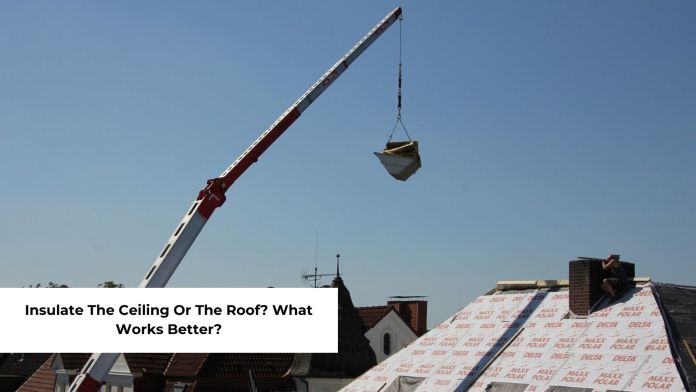Insulating your residential or commercial building is the best way to save money on energy bills. The most proactive place to start would be the top of the building, but that’s where many homeowners and business owners face a dilemma: is it better to insulate the ceiling or the roof?
We’re covering the basics of ceiling and roof insulation to help you decide which alternative is best.
What is the Difference Between Ceiling & Roof Insulation?
Whether you’re choosing spray foam insulation for your ceiling or considering insulated metal roofing systems for your business, you must identify the differences between ceiling and roof insulation.
- Ceiling Insulation: When any insulation is installed within the floor closest to the home’s roof.
- Roof Insulation: Installing insulation on the roof’s slope, above and below the rafters.
Read more: Do I need a license to become a building inspector In Queensland, Australia?
Why Insulate?
There are various reasons why you may want to insulate your roof or ceiling, which include:
- Regulating temperatures in the home or business
- Preventing heat loss and saving energy
- Preventing moisture damage
#1. Ceiling Insulation
Most ceiling insulation methods include using loose-fill or blanket insulation within the attic space of a home or commercial building. Many buildings need some form of insulation to ensure internal temperatures are regulated, which is especially important depending on the climate where you live.
You can cut back on your energy costs by utilizing the floor space in the attic and laying down insulation instead. The process of installing ceiling insulation isn’t incredibly complex, but according to a guide to your next renovation, crafting a careful design plan can help you get the job done efficiently. This includes knowing what insulation to use and how much to install.
#2. Roof Insulation
Heat rises can slip through your roof and cost you a fortune in energy bills. Installing roof insulation can help contain and circulate the heat in your home or commercial business.
As we mentioned, if the attic is an integral component of your home or office building, consider roof insulation to keep it warm in the winter and cool in the summer.
Read more: Can You Live In House While Roof Is Being Replaced?
The Advantages of Ceiling Insulation
There are many advantages and disadvantages associated with insulating your ceiling. However, installing insulation within your ceiling can provide an array of benefits.
#1. Ceiling Insulation Is More Affordable
Insulating your ceiling is generally more affordable than insulating the roof for a variety of reasons:
- To promote air circulation, you don’t have to include extra vents, pipes, or holes.
- You can purchase loose filling in bulk, which means you’ll save money.
- Using a blower or installing the insulation by hand reduces the need to hire a team to insulate your home or business.
- You won’t use as much energy to heat your home or business as your house will stay warmer for longer.
#2. Insulating the Ceiling is Eco-Friendly
The topic of protecting the environment has become quite popular when insulating properties. That’s why it’s considered an eco-friendlier approach. By insulating your ceiling, you’re using y to warm the home/business and reduce the gases and emissions that escape into the atmosphere.
#3. Insulating a Ceiling is Easier
If you’re set on it being a DIY project, insulating the ceiling is the better choice, as you can do it without hiring help. Roofing insulation is a much more complex job and may require a team of contractors.
Read more: Benefits of White Roof Replacement.
The Disadvantages of Ceiling Insulation
Ceiling insulation may only be helpful if the property is older. If there are drafts, cracks, and holes, you will need to install roof insulation to provide better coverage. In addition, the type of insulation you use can impact its effectiveness in keeping your property warm. Choosing the wrong insulation could render the job unsuccessful and require reworking.
The Advantages of Roof Insulation
There are some advantages to insulating your roof rather than the ceiling.
#1. Protection from Moisture Damage
Insulating the roof can prevent frost and ice dams from damaging the roof’s structure. Roof insulation can stop the spread of moisture and keep ice or water from getting absorbed into the home.
#2. Roof Insulation is Energy Efficient
The most distinct advantage is that roofing insulation is more energy efficient. It can help keep the air warm during the winter and the interior cool during the summertime by providing better circulation.
#3. Noise Control
Not only can roof insulation prevent moisture damage, but it can also act as a noise dampener. Think of the insulation as a barrier that separates outside and inside noises.
Disadvantages of Roof Insulation
#1. Roof Insulation is More Work
Installing roof insulation requires a solid plan. You will need the help of a contractor to get the job done correctly. A contractor will know the better methods and materials and understand the regulations associated with roof insulation practices.
#2. Insulating the Roof is Expensive
When comparing the two options, insulating the roof will cost more money. Why? Because you may need to have vents and air ducts installed, you must hire professional contractors to install the insulation and take care of other components.
Read more: Do I need a license to become a building inspector In Queensland, Australia?
Conclusion
Choosing between ceiling or roof insulation will depend on your unique needs. Weighing the pros and cons can help you decide which method is best. We recommend ceiling insulation if you need minimal insulation improvements. Roofing insulation is often the most effective for long-term energy savings. We hope you found this guide helpful.



















